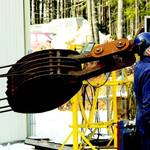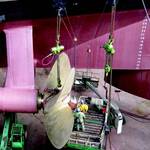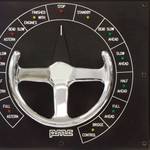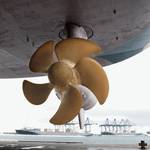
Protecting your people and your physical structure, while ensuring business continuity, are the most important functions of a fixed gas detection solution. Engineering a reliable, high-performance system that makes it easier and more cost effective to meet this challenge is the driving force behind a truly universal approach to gas detection.
Protecting your people and your physical structure, while ensuring business continuity, are the most important functions of a fixed gas detection solution. Engineering a reliable, high-performance system that makes it easier and more cost effective to meet this challenge is the driving force behind a truly universal approach to gas detection.
Based on themodel of “universal truths,” Scott Safety Gas and Flame Detection R&D Engineering Manager, Dan Munson offers direction onhow to evaluate current systems, and project the impact of next-generation gas detection on companies’ safety and productivity in a global economy.Munson discusses the evolution and benefits of designing, implementing and maintaining a truly universal approach to gas detection.
In a global economy, the challenges to personal safety, productivity, and business continuity are magnified. Companies in a wide range of industries, where the presence of combustible and toxic gases are a way of life, must continue to evaluate their gas detection systems or pay the price on many levels. This evaluation must consider a number of factors that can enhance safety, while streamlining installation and minimizing maintenance — in the present and the future. That’s what constitutes a truly universal solution.
Before we look ahead and evaluate a truly universal approach, it’s important to take a look at how gas detection is done with fixed gas detection technology today:
Call it a paradigm shift in response to customer needs. Today, there is an increasing call for higher levels of safety, performance, standardization, economies of scale, ease of use, and overall accountability. Meeting these needs and adding value to the customer experience begins with re-thinking fixed gas detection engineering.
Engineering a universal gas detection system provides its own set of challenges. But these challenges are being met and needs are being fulfilled. As you position your company to leverage a truly universal gas detection solution, you must evaluate where you are and where you need to be. The following exploration of legacy systems used in the field today and truly universal characteristics of next-generation gas detection instruments should aid in your evaluation.
In a fixed gas detection system, a single detector is paired with— and tested with— a single sensor, accommodating only a small number of combustible or toxic gases, whereas a universal system allows for a single gas detector to accommodate multiple sensors, so multiple types of gases can be detected in one location. Working within the same device footprint the transmitter is designed to support different sensing technologies: combustible gas sensing with infrared and catalytic bead sensors and electrochemical and metal oxide semiconductor sensors for toxic gases. Using equally smart sensor technology allows the construction of sensors with multiple ranges in the same package which in turn enables range invariant calibration. One instrument that can provide the capabilities of multiple instruments, and one sensor that can support multiple gas ranges provides valuable flexibility not available in legacy gas detection devices.
Fixed gas detection systems have traditionally relied on analog signals for communication. This limits the transmission of advanced diagnostics data that ensures a safe environment. Adopting digital communication protocols necessitates installing new detectors and/or new sensors.
A universal system is engineered to accept new plug-and-play communication boards, as needs change and new communications protocols are required. This multiprotocol innovation — wired or wireless (when industry appropriate) — means protocols can be added without replacing the transmitter as communication requirements change. Companies will want to make sure their transmitter accommodates a wide range of communication protocols, including MODBUS, HART, wireless HART and wireless ISA100.11A. This kind of flexibility is a key to a futureproof gas detection solution, and the transition from rigid, proprietary systems to standards-based, secure systems that accommodate growth and change.
Due to engineering constraints, sensor calibration in a fixed gas detection system must be performed in the field, where conditions are less than ideal and both safety and performance may be compromised.
Accurate calibration is critical to satisfying both safety and performance requirements. It also impacts productivity when false alarms, due to inaccurate calibration, slow down — or even shut down — production. Next-generation universal gas detection enables a calibration-in the-lab scenario, providing a more controlled and safe environment for establishing gas sensor parameters. This is a significant innovation, especially with legacy cat bead sensors which required proper voltage adjustments at the point of detection. Additionally, the flexibility to calibrate an electrochemical sensor to a particular gas level and then make simple adjustments to the range later—without recalibrating the sensor to the new range—can offer significant efficiencies in sensor maintenance.
Through advanced engineering, a transmitter’s microprocessor can remember the type of sensor installed, as well as all calibration values. This built-in system of checks and balances virtually eliminates duplication of effort and the possibility of installing the wrong sensor.
Global certification, especially when deploying a variety of detectors, as in fixed gas detection systems, can complicate and delay the ability to engage in business around the world.
A universal system expands the certification of a gas detector for global acceptance (including CSA, ATEX, IECEx, INMETRO, GOST-R, China Ex, A & C Tick, Marine Directive — Ship’s Wheel/ ABS and SIL 2 certified by a third party agency) and plays a critical role in facilitating quick global adoption. The process of seeking global certifications can be further streamlined when a single gas detector is flexible enough to accommodate a wide range of toxic and combustible gases.
A fixed gas detection system means that there are more points (i.e., detectors), which means higher maintenance, more complexity and incremental costs associated with added cabling, junction boxes and wiring.
Less is more — and better — when you can reduce the number of points in a gas detection system as with universal systems. One device consolidating three points has a positive ripple effect in terms of installation and maintenance. For instance, at a site with 45 points, accepted practice would include point-to-point wiring, using a Modbus communication protocol wired back to a central location or controller. But with a multi-head scenario, handling three points each, the number of detectors is reduced to 15 devices. This approach represents significant cost savings. In fact, using a single detector that consolidates three points, with a single relay board to control three alarms, totally eliminates a costly controller. Multiply this configuration times three for every three-head detector/ multiple sensor configuration, and your cost of ownership is further reduced.
Multiple manuals or the knowledge of many different product lines can slow the installation process and impede productivity.
And in today’s climate, it is becoming increasingly important to do more with a smaller, less specialized workforce. Truly universal engineering produces solutions that are simple to use with consistency in design making products intuitive, easy to learn and easy to use. This reduces installation time and increases productivity.
A fixed gas detection system includes large inventories of sensors, detector heads and accessories, demanding a significant inventory investment.
With a universal system, a field technician looks in his toolbox and sees fewer sensors, detectors and calibration adapters, as well as fewer accessories (like deluge guards and flow cells). Universal mounting kits simplify the process in new installations, while retrofits to existing installations are significantly more manageable. This simplification also minimizes lapses in safety due to human error.
Exploring a series of “universal truths” about next-generation fixed gas detection is a critical first step in evaluating how you protect your people and maintain the highest levels of productivity. Truly universal gas detection begins with a singularly flexible system, engineered to ensure accurate performance in a wide range of environments; considers current and future manufacturing and shipping environments; and plays a significant role in keeping costs under control in the face of global certification requirements and a changing workforce. How you use this insight will impact where, and how successfully you conduct business.
Combining advanced sensor technology and simple operation, Scott Safety offers a comprehensive range of gas detectors, flame detectors and controllers flexible enough to handle the harshest conditions while helping customers minimize their overall cost of ownership.
The Meridian Universal Gas Detector is an innovative next generation gas detection solution. The Meridian single detector head supports combustible and toxic sensors. Designed for ease-of-use, Meridian significantly reduces upfront investment and ongoing maintenance costs. With global approvals and SIL2 certification from TUV-Rheinland, Meridian provides best-in-class performance and safety, offering the following features:
The Meridian Universal Gas Detector accepts all sensor types in one detector. Whether you need an infrared or catalytic bead sensor to detect combustible gases or an electrochemical or Metal Oxide Semiconductor (MOS) sensor for a toxic environment, the Meridian gas detector utilizes a single detector head to easily accept all sensor types. Simply attach the specific toxic or combustible sensor to the detector head and the Meridian gas detector will automatically determine the type of gas to be detected. Installation of the sensor is a simple plug-and-play action. The Meridian platform is designed to be future proof, allowing you to take advantage of new sensing technologies from Scott Safety while maintaining ease-of-use and peace of mind.
The Scott Safety global marketing team defines a confined space, and discusses ways to successfully recognize and diagnose the most common atmospheric hazards found within.
A confined space is defined as an area large enough for an employee to enter and perform work. These spaces have limited or restricted means of entry or exit and are not designed for continuous human occupancy. According to the National Institute for Occupational Safety and Health (NIOSH), investigations of confined space injuries and fatalities indicate that workers usually do not recognize they are working in a confined space, and they may encounter unforeseen hazards. Testing and monitoring of the atmosphere is not performed, and rescue procedures are seldom planned.
Recognition of potential hazards is not always easy. Confined spaces such as manholes, sewers, boilers, silos, vessels, vats, pipelines, tunnels, storage tanks, ship compartments and underground vaults are often easily identified. However, often overlooked are potential confined space hazards such as open-topped water and degreaser tanks, open pits and enclosures with bottom access.
Confined spaces alone may not be hazardous, but they can become so quickly. And, when coupled with common atmospheric hazards, they can be life threatening. Before entry, a confined space should be monitored for all atmospheric hazards suspected to be present. Common hazards found in the work environment include:
Fixed and portable gas detection instruments are used to identify the presence of atmospheric hazards. Instruments are typically used to detect the presence of toxic gases such as H2S and CO. For combustible gases such as methane or propane, instruments are used to detect concentrations of gas up to the LEL. A gas-air mixture becomes explosive at the LEL, but the monitoring range of most instruments is below this limit to provide advanced warning. Common sources of atmospheric hazards include:
After checking for gases the space should be properly ventilated to reduce the hazard level as much as possible. Proper attendants and rescue equipment should be in place before making any confined space entry. If the space is or has the potential to be Immediately Dangerous to Life and Health (IDLH), workers must wear a tight-fitting positive pressure, air supplied respirator. A NIOSH-approved self-containing breathing apparatus (SCBA) or supplied-air respirator (SAR) with egress cylinder are the most appropriate respiratory protection options.
Grade D breathing air is provided to a worker wearing a supplied-air respirator (SAR) via a portable air cart, remote cylinders in a trailer or stored as plant breathing air, a Grade D breathing air compressor or filtered air from an industrial air compressor. The duration of a supplied-air respirator is limited to the capacity of the supplied air source. Because of the design of extended duration airlines, the possibility of the air source being interrupted requires that all supplied-air respirators used in IDLH situations include an egress cylinder providing enough Grade D breathing air to escape to a safe environment.
Scott Safety Product Line Manager, Tony Pickett, suggests that “preparing to deal successfully with any emergency situation requires careful planning and training. All personnel on board need to know how to behave in an emergency and those responsible for carrying out lifesaving tasks must be familiar with the equipment they need and know how to use it safely and effectively. This, together with working with a reputable manufacturer will help reduce unnecessary deaths and serious injury in this demanding industry.”
With simple, intuitive operation and automated functionality, our portable gas detection solutions reduce the likelihood of user error and provide greater peace of mind, so the focus is on the job, not on the equipment.
The PS200 is a rugged, easy to use portable multi-gas detector ideal for use in confined spaces and hotworks. Both lightweight and durable the instrument monitors and displays up to four hazardous gas conditions simultaneously using catalytic bead sensor technology for a wide range of combustible gases, and electrochemical sensors for carbon monoxide, hydrogen sulfide, and oxygen deficiency. Operator interface and calibration are intuitive and easy by toggling between simple one-button functions. During hazardous conditions users are alerted via three alarm functions: vibration, red flashing LEDs, and audible buzzer. To ensure the highest level of personal safety, the PS200 is also fitted with an optional man down/motion sensor that activates alarms if the instrument is not moved at a pre-set time. The instrument is also fitted with an optional built in remote sampling pump making it ideal for use in confined spaces. The PS200 features a screen backlight that can be manually switched on in poor lighting conditions. Additional features include: customized user identification code setup, calibration due date display, and standard data logging that can be downloaded to a docking station via USB connection to a computer. Also available is a auto bump and cal station, charger and PC data logging software.
IEC Ex ia d IIC T4 Gb
ATEX
cCSAus
CE
CSA
MED
Rooted in more than 75 years of heritage and dedication to safety, Scott Safety has constantly expanded to provide safety solutions for new markets and challenges. Today, we work with dozens of global industries, including general industry, petrochemical oil and gas, marine, asbestos, first responders and military and civil defense. With five manufacturing facilities and a customer base that spans more than 50 countries, Scott Safety has a broad, global offering of innovative safety products, with a premium portfolio of SCBA, air purifying respirators, gas detection systems, compressors, PPE, and thermal imaging products.
Scott Safety is committed to becoming a world leader in gas detection as demonstrated by the recent acquisition of Industrial Safety Technologies (IST). The advanced products manufactured by Detcon, Simtronics, Oldham, and Gas Measurement Instruments (GMI) together with the Scott Safety offerings provide holistic gas detection solutions, with some of the most advanced technologies in the market for the marine industry.
IST holds a technology leadership position in the gas and flame detection industry and is strongly committed to innovating in industrial safety solutions. From groundbreaking wireless gas-detection technology to the first SIL3 certified triple IR flame detector, IST provides among the most advanced and reliable solutions, protecting lives and workplaces around the world. IST brings strong market presence in Europe, the Middle East, and the Gulf Coast U.S. region and will complement the Scott Safety Flame and Gas Detection business.
The National Oceanic and Atmospheric Administration (NOAA) estimates that more than 700 million gallons of petroleum enter the environment each year, more than half of which is due to irresponsible discharges and illegal disposal. Oil leakage from stern tubes, once considered a part of normal operational consumption of oil by ocean-going vessels, has become an issue of concern and is now considered oil pollution.

GE Marine is one of the world’s leading manufacturers of marine propulsion products, systems and services including aeroderivative gas turbines. These highly efficient marine engines meet current and future emission regulations, and offer superior availability for various commercial and military applications. GE gas turbine propulsion systems and solutions are being used in some of the most novel projects such as to power the world’s fastest commercial ship as well as the United States Navy’s new LHD amphibious assault ship.

Hawboldt Industries was founded in 1906 in Chester, a small town in rural Nova Scotia, Canada. After more than 100 years, the company still resides in the same town but its business and product focus has changed dramatically. From its humble beginnings primarily servicing the local Nova Scotia marine and fishing market, Hawboldt products now reach a global customer base and serve a dynamic group of market segments.

According to Bureau of Labor Statistics, a total of 717 work injuries occurred as a result of contact with objects and equipment in 2013. Roughly, 245 of them were struck by falling objects and another 105 workers were fatally injured after being caught in running equipment or machinery. Needless to say, anything can happen on a jobsite. Your equipment could malfunction or the weather might cause a whirlwind of unexpected issues, or even worse, someone could get hurt. Unfortunately, not much can be done when circumstances such as those arise, which is why developing preventive strategies is crucial to having a successful and safe project. One of those strategies is always choosing safe and reliable lifting equipment. But the question that remains is: is it safer to rent or to buy?

Prime Mover Controls (PMC), based in Burnaby, B.C., Canada, began in 1969 as a small governor service shop, servicing virtually all types of Woodward governors. Over the years, PMC has kept up with new developments in governor technology and has maintained a dedicated and experienced staff of service technicians, as well as extensive test equipment. Servicing and adapting new Woodward governors to a wide variety of applications, both on and offshore, continues to be a significant part of PMC’s business.

When the Environmental Protection Agency (EPA) issued the new Vessel General Permit (VGP) in December 2013, lubricant and fluid manufacturers were prepared to give vessel owners a number of environmentally acceptable lubricants (EAL) to work with. EAL usage is now essentially required for any application on vessels where incidental lubricant discharge could occur in the marine environment. Those applications include stern tubes, thrusters, stabilizers, CPP propellers, and wire rope and mechanical equipment immersed in water during normal operation.